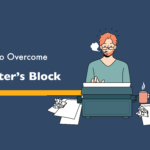Most blog posts suck. There is too much boring, forgettable content on the internet.
Many writers either don’t want to make an effort to create unique posts or rely entirely on AI to do the “creative thinking” for them, then wonder why their content falls flat.
On the flip side, maybe you’ve written a kickass blog post, but it barely got any engagement.
The truth is that content writing and marketing are constantly evolving. Strategies that worked a few years ago won’t cut it today.
Even Google now prioritizes and ranks people-first content that satisfies user intent over keyword-stuffed pieces.
So, how do you create blog posts that grab attention, keep readers engaged, and make them come back for more?
Here are 11 content writing tips to help up your writing game.
1. Start with a killer hook
Studies show that the average human attention span is 8.25 seconds — shorter than a goldfish’s 9 seconds.
This means you’ve got only a few seconds (and your first few sentences) to capture the reader’s attention; otherwise, they’re gone.
Your readers won’t stick around to “figure out” what your article is about. Instead, it’s your job as the writer to hook them from the start.
A compelling hook will grab the reader’s interest enough to prompt further reading. Open with a question, a bold statement, a scenario, or an interesting fact that makes them go, “Wait, what?”
Imagine starting a post with a question like, “Want to learn how to retire before you’re 45?” or a contrarian hook like, “Why goals are overrated and what to do instead.”
Either of these hooks triggers curiosity, maybe even a minor disagreement, and that’s precisely what you want.
You want the reader to stop, think, and keep reading.
2. Write the way you talk
I get the need to sound polished, professional, and impressive. But remember, your readers are actual humans, not robots.
They’re regular people looking for relatable content, so ditch the overly formal tone. Write like you’re having a conversation with a friend over coffee. Keep it natural, simple, and easy to digest.
When you write conversationally, your readers feel like they’re engaging with a real person, not reading a philosophy article. And that makes them more likely to become loyal visitors.
With AI derangement syndrome becoming increasingly prominent, the only way to stand out is to sound distinctly human.
A personal trick? Read your content out loud. If it sounds awkward, rewrite it until it flows naturally. If you trip over a sentence while reading, your audience will, too.
Apart from your audience, the best part is that writing this way is also great for search engines.
Like Google’s AI overviews, AI-powered search results prioritize clear, well-structured content. The easier it is to read, the easier it is for algorithms to parse and feature it.
So, by keeping things conversational, you improve your reader’s experience and increase your chances of more visibility, better credibility, and organic site traffic.
3. Know your audience
Many times, writers make the mistake of focusing on what they want to say rather than what their audience needs to hear. As a result, their content falls flat because it doesn’t resonate with the key people they’re trying to reach.
So, before you start writing, ask yourself:
- Who am I speaking to?
- What problems do they have?
- What motivates them?
- What kind of tone and style will resonate with them?
- Where are they on their buyer’s journey (if you’re selling a product)?
Take the time to understand your audience, then craft your content around their needs and wants. The better you understand your audience, the more engaging and relevant your content will be, and the better the results you’ll get.
4. Structure like a pro
Have you ever stumbled on a post that was just a wall of text? No spaces. No subheadings. There are no clear breaks. It’s just an intimidating block of words.
Nobody has the patience for that. If your post looks overwhelming, your readers will bounce before they even start.
A well-structured post will guide search engine crawlers (and readers) from one point to the next, so it’s easy to follow, crawl, and understand.
Besides, most people skim blog posts, and the right structure helps them find the parts they’re interested in reading.
With that in mind, here’s how to structure your posts:
- Start with a clear introduction that maps out what your post is about
- Use headings and subheadings to break up content and improve readability
- Use short paragraphs (2–3 sentences, max)
- Include engaging visuals and infographics
- Use bullet points and lists to highlight important information
- Conclude by summarizing or using a call-to-action.
Remember, human attention spans are short, so let your content breathe. Before you publish it, ensure it’s easy to scan so readers can pick up key points quickly.
Also, you can speed up the brainstorming and outlining phase by using tools like ChatGPT and Undetectable AI. Don’t forget to humanize every AI output to bypass detectors and avoid SERP penalties.
5. Focus on clarity over complexity
Contrary to popular belief, big words don’t make you sound smart—no, I’m not trying to be condescending.
Clarity should always be a top priority when it comes to creating content.
Your job as a writer isn’t to flex your vocabulary muscles but to pass your message across. Adding unnecessary or complicated jargon only confuses your audience.
Aim for simplicity and readability, not complexity; you’ll have more powerful and persuasive content.
This doesn’t mean you can’t use big, fancy words; just make sure that it doesn’t compromise clarity.
In my experience, a simple trick is to have a 12-year-old review your work. If they understand your point, you’re on the right track.
No 12-year-old around? Use a tool like Hemingway Editor, which will highlight dense sentences and help you keep things clear.
When you master clarity, your content becomes impossible to ignore.
6. Add a bit of personality
Anyone can write about “How to create better marketing emails,” but what makes your version different is YOU: your personality, your perspective, your unique storytelling style.
Be like Duolingo: inject humor, share personal experiences, and let your personality shine through.
Of course, the level of personality depends on your industry and audience. But every niche has one—whether fun, casual, professional, or technical.
A B2B cybersecurity article, for example, might not be the place for dad jokes (or maybe it is?), while a lifestyle blog thrives on a friendly tone.
Let your readers feel the person behind the words. A little bit of quirkiness or storytelling can make your content more engaging and relatable.
At the end of the day, people may forget what you said, but they will never forget how you made them feel.
7. Make it actionable
Approximately 7.5 million blog posts are published online every day. These blogs teach something new, answer a question, or solve a problem.
With these many articles online, it’s important to stand out with posts that compel people to move on to the next stage of the sales funnel. Otherwise, all your hard work of getting noticed is for nothing.
Give your readers:
- A tip to try,
- A tool to use,
- Or a challenge to tackle.
Don’t just tell them about the easy-to-make cheesecake you baked. Give them the recipe, as well as alternative ingredients. If possible, embed step-by-step pictures or video explanations.
The more practical your content, the more valuable it becomes. And valuable content keeps readers coming back for more, making them more likely to engage with your brand as a whole.
Of course, this signals to search engines that your content (and overall site) is useful, leading to higher ranking on search result pages.
In short, actionable content should address the reader’s pain and educate them on how to achieve something.
8. Use strong visuals
Humans are naturally drawn to visual stimuli and process visual information faster than text. That’s why content with relevant images gets 94% more views than text-only posts.
So, writing valuable content is not enough; you also have to please your audience’s eyes. Add images, infographics, GIFs, screenshots, or diagrams to encourage people to engage with the content and spend more time on the site.
For example, if you’re writing a how-to guide, a step-by-step screenshot can explain your ideas better and prevent your readers from being confused.
To get high-quality images, take advantage of free resources like Unsplash, Pexels, and Google Images (just be mindful of copyright). Tools like Canva also offer helpful templates for creating your own graphics.
9. Write magnetic headlines
Don’t judge a book by its cover, they say. But what about its title?
Like hooks, your headline is the first (and sometimes only) thing people read. If it’s not compelling enough, they’ll scroll right past it.
Take, for example, the intriguing title “The Listening Eye” by Patricia Wentworth. It stops you in your tracks.
Isn’t the eye for seeing? How does an eye listen? Many questions flood your mind, and you’re curious to know more.
That’s exactly what your headlines should do — trigger curiosity and make people click. Coming up with great headlines requires careful thinking and creativity, but here are a few tips to consider:
- Pose an interesting question. It could be a “what-if” scenario or something more thought-provoking.
- Use active voice instead of passive voice.
- Use a bold headline backed by evidence.
- Create curiosity gaps to engage your readers.
- Aim for 6-8 words that hit the guts.
- Avoid clichés and overused words.
10. Edit your content
All content writing tips go to waste if you don’t edit your content.
Aside from the messiness of every writer’s first draft(s), the real magic happens in the editing phase.
This is where you turn a rough, subpar draft into an outstanding piece that invites readers and drives actual results.
If you’re working solo, don’t edit your work on the same day. Your brain is still attached to what you just created, and the chances are high that you’ll overlook weak spots.
Instead, take a break, ideally a few hours or even overnight, then return to it with fresh eyes. You’ll be amazed at how much better you can edit with a clear mind.
When editing, focus on clarity, flow, and engagement. Remove unnecessary elements, simplify complex ideas, and ensure that each sentence earns its place. If something adds no value, remove it.
Thoroughly proofread your work, too. Check for grammar mistakes, typos, awkward sentences, and inconsistencies. Tools like Grammarly can help, but don’t rely solely on them. They’re not solid in understanding “human” tone or style.
If possible, have a friend or a colleague review your work. A second pair of eyes can catch things you missed and suggest improvements you hadn’t considered.
11. Keep practicing
Remember that practice makes perfect. Like any skill, writing gets better with practice.
If you ever feel stuck or unsure about your writing, that’s completely normal. Every “good” writer started somewhere and occasionally battles imposter syndrome.
Some quick ways to level up your writing:
- First, know the medium and purpose of your writing.
- Write every day (even if it’s just a little). A short paragraph daily can keep you in the habit.
- Analyze content from top writers in your niche. Pay attention to what they’re doing, learn from them, and apply those techniques to your work.
- Learn from feedback and keep trying new approaches. Whether it’s comments, client edits, or fellow writers—always crave feedback and experiment till you find your voice.
The more you do it, the easier it gets. So, keep at it and don’t overthink it.
Final words
With the competition out there, creating an outstanding post requires strategy, skill, and patience. To recap, focus on the following content writing tips:
- Knowing your audience better and providing better quality content that resonates with them
- Engaging your readers from start to finish with interactive and visual content
- Creating actionable content that addresses your readers’ pain points and teaches them how to achieve something
- Letting your personality shine through to build a connection with your readers
- Crafting headlines that grab attention and encourage clicks
- Ultimately, keeping your content simple, well-structured, and easy to read
Need expert assistance and content writing tips? Reach out to us right away.
Who wrote this?
Joanna is a versatile content writer with a knack for creating helpful content that resonates with others. When she’s not typing away, she finds solace in quiet moments, music, and cinematography videos. She believes she has an untapped well of creativity inside her and she’s willing to dig deep to fetch it out.
- Joanna Alihttps://roninpoint.com/author/joanna/
- Joanna Alihttps://roninpoint.com/author/joanna/
- Joanna Alihttps://roninpoint.com/author/joanna/
- Joanna Alihttps://roninpoint.com/author/joanna/April 20, 2025









